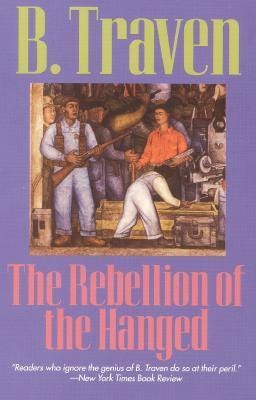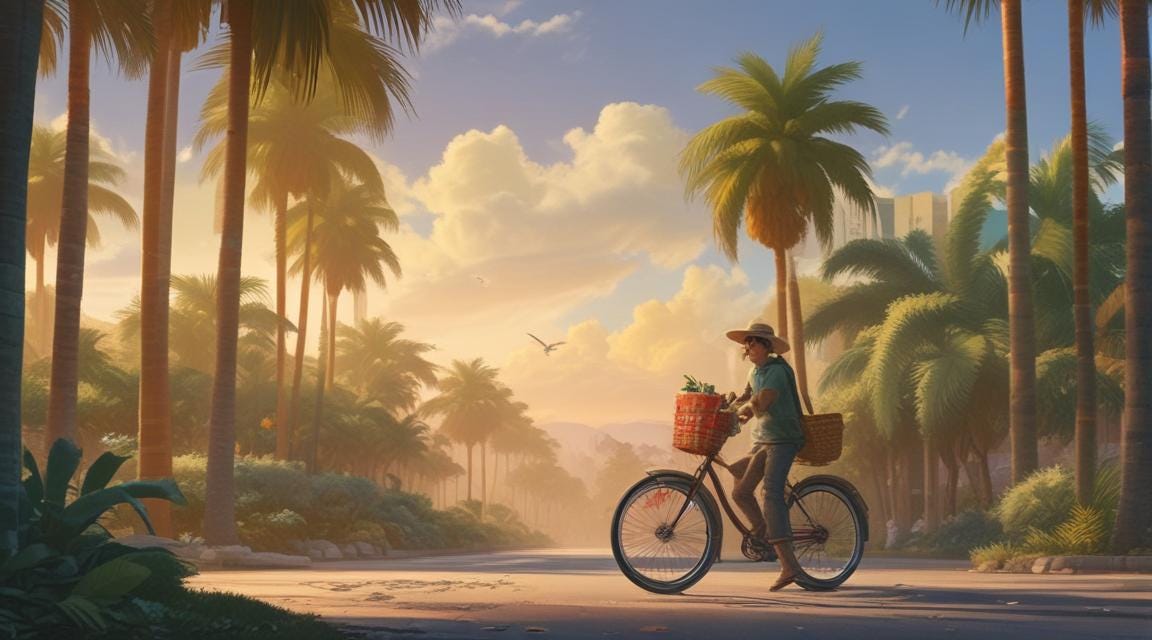Hola Amigos! I want to share an amazing coincidence with you about the power of Substack. In Chapter 17, Tales from the Yucatán, I wrote about finding Yesterday’s Books and meeting the store owner, Mildred. Well, Linda Spence contacted me recently to let me know she was Mildred’s niece. A genealogy search had been done on Mildred, and the google gods located my post! Linda got in touch with me. Here’s her note: “My aunt was Mildred Eshnaur, the proud owner of Yesterdays Books in Moss Landing. My daughter found your wonderful chapter where you so kindly remember Mildred and her bookstore. Thank you for writing about her.” I let Linda know Mildred would re-appear in Chapter 24. And so it goes! Now onward to today’s chapter—By the time our first two-week stay in Puerto Morelos was over, we’d tested our sea legs on the highways and byways of the Yucatán. We would soon be back to the work-a-day world in San Francisco where we’d continue to make preparations for the day when we could eventually call Mexico home.
After our trip to Ek Balam, we were back on the autopista heading to Puerto Morelos. I snuggled into the front seat with pen in hand, letting Paul do the driving while I made a list of all the books I wanted to read to keep up with my blossoming Maya-mania. My early travels had always been preceded by literary adventures and my current pursuit of the Maya would follow the same path.
My Mexico passion came in waves. I read Carlos Castenada’s Teachings of Don Juan: A Yaqui Way of Knowledge and delved into Mexican mysticism. Then I stumbled onto B. Traven when I traveled the gringo trail, starting with The Treasure of the Sierra Madre, his tale of greed and gold. I continued with his Jungle Series detailing hellish working conditions forced upon indigenous Maya in the mahogany camps of Chiapas. My favorite was The Rebellion of the Hanged.
I labored through D.H. Lawrence’s The Plumed Serpent, read Malcom Lowry’s Under the Volcano and digested Graham Greene’s The Power and the Glory. Fuentes’ magical realism swept me away. I rapidly read Harriet Doerr’s bittersweet tale, Stones for Ibarra.
Now I was onto Maya studies. I’d picked up two famous books, Popul Vuh and Chilam Balam. The Popul Vuh, or Maya Bible, was infused with Maya cosmology, mythology, and religion. The Chilam Balam, an ancient Maya text, had been written by “prophet priests,” according to archeologist Sylvanus Morley, in conjunction with church status quo in the 17th and 18th centuries. Written long after the conquest and on paper rather than bark, I questioned its authenticity.
I considered reading Account of Matters in Yucatan, by Diego de Landa, the priest whose religious zeal prompted the burning of all but four Maya codices relegating their history and culture to centuries of unsolved mysteries. According to historical sources, de Landa was forced by the Spanish crown to write the book to encapsulate all that had been lost. I never could bring myself to read it.
My new list included Forest of Kings by Linda Schele and David Freidel, Breaking the Maya Code and The Maya, by Michael Coe, The Last Lords of Palenque, by Robert Bruce and Victor Perrera, Incidents of Travel in Yucatán, by John Lloyd Stephens and Frederick Catherwood, and Time and the Highland Maya by Barbara Tedlock.
While I daydreamed about the Maya and all things Mexican, Paul provided the driving and soon we were back on the coast. The Yucatán seemed a world away and even though we’d had an enjoyable trip, I was glad to be back at the beach.
Before we left for the States we planned to meet with Joe Marino to talk about putting in a small koi pond. In time we planned to collect replicas of Maya artwork to be displayed on the grounds and add colored night lights for effect.
Eventually the koi pond had a fountain with a statue of the head of Palenque Ruler Pakal mounted in the center. We built a cement bench nearby so we could watch the fish. We planted hundreds of coco palms over the years, both the local species, known only as ‘coco,’ and the disease resistant Malay, a palm from Malaysia that could withstand the lethal yellow rot that had killed off all coconut palms on the Quintana Roo coast starting in the early 1990s. The disease had spread to Mexico from Florida and coco palms were almost universally wiped out because of it.
Shipping matters
When Joe came over to discuss the pond, we asked him the logistics of shipping our things when the time came, including my growing library of books, from San Francisco to Puerto Morelos.
“Just ship everything down and see what happens. Don’t bother about paperwork. They’ll work something out. It’s done all the time,” he assured me.
“But Joe, I already have thousands of books. I’m an avid reader and I’m thinking of opening a bookstore.”
“You gotta be kidding. No one reads here.”
“Well I do. And so do lots of people. I’m constantly bringing suitcases filled with books for everyone I know. What about the information we’re supposed to have when we ship things here. Receipts, manifests, stuff like that?
“The Mexican Consulate says we need that to qualify for a one-time exemption from paying customs tax if you’re planning to make Mexico your permanent residence.”
Customs manifests? Fuhgeddaboudit
“You worry too much! Just pack everything! For shipping you’ll have to use Hybur Trade in Florida. Since the Chiapas Incident all other shipping companies pulled out of Mexico. Nothing like a little revolution to shake up corporate America.”
“I’ll check with Hybur then I’ll have to line up a cross-country freight line. This won’t be cheap. No one is crazy enough to ship all that weight.”
“Only you!” Joe laughed.
“My reading habit is proving to be one expensive hobby. But at least I’ll have books for the beach if I don’t start a bookstore.”
A week later we were back in San Francisco. Time moved slowly but this allowed us the leisure of collecting more books for our growing collection and to do a thorough spring house cleaning. Eventually we’d have a garage sale to sell off what we wouldn’t need in Mexico—basically everything.
We couldn’t wait to move to our little fishing village. Over the years we started to count the quirks that made the place charming, albeit in an impractical way. For example, the postman was also the garbage man. I couldn’t understand why I never received letters sent to me in Mexico. Then a local friend asked if we were tipping the postman.
Of course not! I didn’t know you tipped the postman. Well, in Mexico you do. I assumed since I didn’t tip him, he’d been throwing my letters into the garbage.
Post office blues
After a quick change of habit, the postman dropped letters at the house. Many times if I had a package, the notice to pick up said package came the day after it was sent back to the US if not acknowledged. Timing is everything.
But, I reminded myself, we did not move to Mexico for the postal system. Regular mail on average took three to four weeks to arrive from the States. Christmas cards arrived around mid-March. A friend told us to never mail anything of worth through the Mexican system as postal workers would most likely confiscate it. This changed over the years when Vicente Fox became president and initiated a no graft policy, but more efficient options surfaced, like finding someone heading north and asking them to mail letters stateside.
One year I returned to Puerto Morelos after our summer visit north and went to the postman’s house to collect letters that may have arrived while I was gone. Going there was always a treat because I could usually count on something out of the ordinary.
Don Chevo, our postman, was a colorful addition to Puerto Morelos. When not riding around town on his ancient bicycle with his wire basket chock-full of letters, he could be found at home where his dining room table served as postal headquarters.
DIY delivery
He was a gem, a Mexican version of the postman in the Italian move, Il Postino. This time he’d been sick with lumbago and mail delivery was more sporadic than usual. When I asked if I had mail, he pointed to four huge plastic bags behind the couch, filled to the brim.
I was dumbstruck. “Those are letters?”
He gave a slight shrug. “Si.”
Did I want to go through them for letters addressed to me? Being Type A, I accepted the challenge. I went through all the bags and found a few letters plus a couple letters for friends which I asked if I should deliver.
Soon after that fiasco we got a post office box in Cancun. But these were the things we loved about Mexico, the fact that living in the country was different from the US. Life was slower, not so much pressure placed on the ordinary.
I even discovered that mañana, the word for tomorrow in text book Spanish, doesn’t even really mean tomorrow, as in, “The plumber will be here mañana.” As a friend explained, it simply means, “Not today.”
Asi es.
Do you read books about places you’re traveling to before you go? Have you read any books about Mexico or the Maya? What are your favorites? Let me know in the comments. I’d love to hear from you!
If you’re interested in supporting well-researched and thoughtful writing and you’ve been enjoying my posts and are in the mood to be generous, your paid subscription would make my day. Keep up to date on Mexico, travel, chapters from Where the Sky is Born—how we bought land and built a house on the Mexico Caribbean coast. And opened a bookstore, too! All for $5/monthly or $50 per year.
Hit the heart at the top of this email to make it easier for others to find this publication and make me very happy.
Backstory—Puerto Morelos sits within 100 miles of four major pyramid sites: Chichen Itza, Coba, Tulum and Ek Balam. By living in close proximity to this Maya wonderland we pyramid hopped on our days off from Alma Libre Libros, the bookstore we founded in 1997. Owning a bookstore made it easy to order every possible book I could find on the Maya and their culture, the pyramids, the archeologists who dug at these sites and the scholars who wrote about them, not to mention meeting archeologists, tour guides, and local Maya who popped into the store. I became a self-taught Mayaphile and eventually website publishers, Mexican newspapers and magazines, even guidebooks asked me to write for them about the Maya and Mexico. I’ll never stop being enthralled by the culture and history and glad there’s always new news emerging for me to report on right here in Mexico Soul. Please share this post if you know others interested in the Maya. Thank you!
If You Liked This, You Might Also Like . . .












Wow Jeanine that’s a lot of books to read and to ship! Loved reading about your postman. And same in Costa Rica- mañana just means, not today!!
Thank you for your book list, it has inspired me! One thing I was wondering about while reading this post is how Puerto Morelos has changed between "then" and "now." Such as the postman on his bike and other cultural day-to-day experiences. Could you write about this sometime?